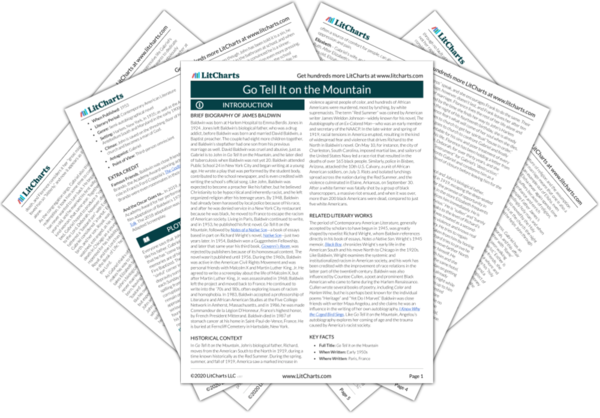As Go Tell It on the Mountain focuses on God and religion, it also examines sin and morality, and sex and sin go hand in hand in Baldwin’s novel. The Old Testament identifies “fornication,” or sex outside of marriage, as a direct sin against God, and this belief is reflected throughout Go Tell It on the Mountain. Sex is a constant threat to the morality of Baldwin’s characters, and those who partake in sex out of wedlock are consumed by guilt and deep religious shame. To indulge in sex for reasons other than procreation is considered immoral and abject, and those who commit this sin are likewise considered wicked; however, many of Baldwin’s characters who are tainted by sexual sin are otherwise righteous and good people. As the novel unfolds, Baldwin ultimately implies that sex outside of marriage isn’t the worst sin that one can commit—if it is even a sin at all—and he ultimately argues that having or abstaining from sex is a poor indicator of one’s morality. In this vein, Go Tell It on the Mountain forces the reader to reconsider what, and who, they typically view as moral or immoral.
From the outset, sex is established as a sin in the world of Go Tell It on the Mountain. Father James, the preacher at John’s church, publicly condemns Elisha, a young man and fellow preacher, for spending time with Ella Mae, another young church member. Elisha and Ella Mae are “walking disorderly,” Father James says, and “in danger of straying from the truth.” Father James fears they are in peril of plucking “the unripe fig” “too early from the tree.” Even the mere possibility of sex is enough to bring their morality into question. John, too, claims to have sinned: “[John] had sinned with his hands a sin that was hard to forgive. In the school lavatory, alone.” John doesn’t have sex per se but “sins” in the form of masturbation, which he believes is nearly unforgivable. Sin is intimately linked with sex in Baldwin’s novel, so much so that even the implication of sex, be it through masturbation or adolescent crushes, is enough to render one a sinner and morally deficient, but Baldwin appears to disagree. John is not morally deficient, and neither are Elisha and Ella Mae, and their tangential, and rather innocent, relationship to sex is not enough to make them immoral.
Many of the central characters struggle with their perceived sexual sins. Religion tells them sex outside of marriage is a mortal sin that must be atoned, and many of the characters struggle with the moral implications of their sexual pasts. When Deborah, who later becomes Gabriel’s first wife, is brutally raped by a group of white men, she becomes “a living reproach” to her community. Even though she was raped and thereby violently forced into sex, she is still “looked on as a harlot.” To atone for this alleged sin, Deborah devotes her entire life to God, “like a terrible example of humility, or like a holy fool,” but Baldwin implies that this atonement isn’t necessary. Deborah was an innocent victim in her rape, and she is an exceedingly kind and righteous woman. In fact, Deborah’s community is convinced she is “the greatest saint among them, the Lord’s peculiar treasure and most holy vessel.” Deborah’s rape, Baldwin implies, has absolutely no real bearing on her morality. Gabriel’s second wife, Elizabeth, also struggles with sexual sin. She enters a sexual relationship with her fiancé, Richard, and after he dies, she is left pregnant and alone. Elizabeth believes that “God had taken [Richard] from her” as payment for her sin of “lust,” of which her “bastard son,” John, is an “heir.” But, Baldwin implies, God didn’t really “take” Richard from Elizabeth as punishment for her sin: he committed suicide after he was falsely accused of robbery and imprisoned by his racist society. Furthermore, Elizabeth and Richard were in a loving and committed relationship, and she was by no means promiscuous. Elizabeth only believes she has sinned because she believes what her religion says about sex—that any sex out of wedlock and the children it may produce are mortal sins that must be repented—but through Elizabeth and Deborah, Baldwin challenges this perspective.
The relationship between sex and morality is further complicated with the implication of John’s homosexuality. When he masturbates in the school bathroom, he thinks of boys, and when he watches Elisha preach at church, he admires how Elisha’s suit hangs on his “lean” and “strong” body. John “never dares to speak” of “the darkness of [his] sin,” which the Bible also identifies as a mortal sin, but he spends much of his time trying to atone for it. He prays and attends church regularly, excels in school and doesn’t associate with neighborhood troublemakers. He is kind and a good son to his mother, and, Baldwin thereby contends, John’s sexuality does not make him immoral, just as it is not Gabriel’s sexual history that makes him wicked but his self-righteousness and unthinkable cruelty instead. Ultimately, Baldwin’s exploration of sex and morality in Go Tell It on the Mountain challenges basic assumptions of sex and sin and forces the reader to assess morality based on a much broader—and more nuanced—spectrum, not simply in terms of sex or sexuality.
Sex and Morality ThemeTracker








